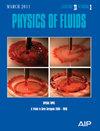对 Π 型桥梁涡致振动的研究以及利用 G 型挡板组合措施抑制涡致振动的方法
IF 4.1
2区 工程技术
Q1 MECHANICS
引用次数: 0
摘要
Π型钢-混凝土组合梁是一种常用的桥面结构,由上部混凝土板和下部横向两片工字钢梁组成,经常会产生严重的涡激振动(VIVs)。本文采用 1:50 比例截面模型风洞试验和流场数值模拟,系统研究了 Π 型梁的 VIV 响应和触发机制。随后,设计了几种空气动力措施来缓解原断面存在的显著 VIV,并找到了一种由 G 型挡板和下部中央稳定板组成的有效措施。数值模拟结果表明,Π 型大梁的上表面和下表面都出现了严重的涡流脱落现象,这两种现象对 VIVs 的发生有很大的影响。因此,为 Π 型大梁引入的空气动力措施必须能够同时改善截面上下表面的绕流情况,而 G 型挡板和下部中央稳定板可同时实现这一目标。结果表明,这种 G 型围裙组合措施的 VIV 抑制效果受 G 型围裙竖板高度和下中央稳定板高度的影响很大。只有两者都达到一定高度,该措施才能完全防止Π型梁发生 VIV。经过形状优化,提出了一种在约 0.5% 的低阻尼比下可完全消除 Π 型大梁 VIV 的 G 型围裙组合气动措施,并通过 1:20 截面模型的风洞试验验证了其抑振效果。本文章由计算机程序翻译,如有差异,请以英文原文为准。
Investigation of vortex-induced vibration of a Π-type bridge girder and its suppression using G-shaped apron combination measure
The Π-type steel-concrete composite girder, a commonly used bridge deck composed of an upper concrete slab and two lower lateral I-side steel girders, often suffers from severe vortex-induced vibrations (VIVs). Herein, the VIV response and triggering mechanism of a Π-type girder are systematically investigated, by adopting 1:50 scale section model wind tunnel tests and flow-field numerical simulations. Afterward, several aerodynamic measures were designed to mitigate the significant VIVs present in the original section, and an effective measure composed of the G-shaped apron and lower central stabilizer plate was found. Numerical simulation results show that the Π-type girder's upper and lower surfaces both exhibit severe vortex shedding, and both contribute significantly to the occurrence of VIVs. Consequently, the aerodynamic measures introduced for the Π-type girder must be able to simultaneously improve the flowing bypassing situation around the upper and lower surfaces of the section, and the G-shaped apron and the lower central stabilizer plate could both accomplish this simultaneously. The results show that the VIV suppression effect of this G-shaped apron combination measure is greatly affected by the height of the G-shaped apron's vertical plate and the height of the lower central stabilizer plate. Only both of them to a certain height, this measure can entirely prevent the Π-type girder from VIVs. After shape optimization, a G-shaped apron combination aerodynamic measure that can eliminate completely the Π-type girder's VIVs at low damping ratios of about 0.5% is proposed, of which the vibration-suppressing effect was verified by wind tunnel testing of 1:20 section model.
求助全文
通过发布文献求助,成功后即可免费获取论文全文。
去求助
来源期刊

Physics of Fluids
物理-力学
CiteScore
6.50
自引率
41.30%
发文量
2063
审稿时长
2.6 months
期刊介绍:
Physics of Fluids (PoF) is a preeminent journal devoted to publishing original theoretical, computational, and experimental contributions to the understanding of the dynamics of gases, liquids, and complex or multiphase fluids. Topics published in PoF are diverse and reflect the most important subjects in fluid dynamics, including, but not limited to:
-Acoustics
-Aerospace and aeronautical flow
-Astrophysical flow
-Biofluid mechanics
-Cavitation and cavitating flows
-Combustion flows
-Complex fluids
-Compressible flow
-Computational fluid dynamics
-Contact lines
-Continuum mechanics
-Convection
-Cryogenic flow
-Droplets
-Electrical and magnetic effects in fluid flow
-Foam, bubble, and film mechanics
-Flow control
-Flow instability and transition
-Flow orientation and anisotropy
-Flows with other transport phenomena
-Flows with complex boundary conditions
-Flow visualization
-Fluid mechanics
-Fluid physical properties
-Fluid–structure interactions
-Free surface flows
-Geophysical flow
-Interfacial flow
-Knudsen flow
-Laminar flow
-Liquid crystals
-Mathematics of fluids
-Micro- and nanofluid mechanics
-Mixing
-Molecular theory
-Nanofluidics
-Particulate, multiphase, and granular flow
-Processing flows
-Relativistic fluid mechanics
-Rotating flows
-Shock wave phenomena
-Soft matter
-Stratified flows
-Supercritical fluids
-Superfluidity
-Thermodynamics of flow systems
-Transonic flow
-Turbulent flow
-Viscous and non-Newtonian flow
-Viscoelasticity
-Vortex dynamics
-Waves
 求助内容:
求助内容: 应助结果提醒方式:
应助结果提醒方式:


